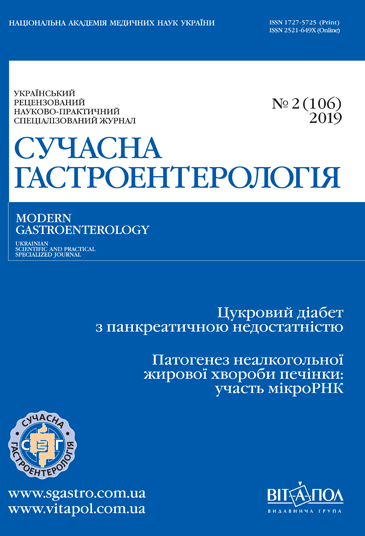Ефективність антигістамінних і антилейкотрієнових препаратів у лікуванні синдрому подразненої кишки у хворих із супутніми алергійними захворюваннями
DOI:
https://doi.org/10.30978/MG-2019-2-22Ключові слова:
синдром подразненого кишечника, алергійні захворювання, гістамін, діамінооксидаза, антигістамінні препаратиАнотація
Мета — уточнити роль гістаміну в патогенезі синдрому подразненої кишки (СПК) та встановити ефективність антигістамінних і антилейкотрієнових препаратів у комплексній терапії пацієнтів із СПК
Матеріали та методи. Дослідження проведено у 2016 — 2017 рр. на базі кафедри внутрішньої медицини № 1 Національного медичного університету імені O. O. Богомольця. Обстежено 150 хворих із СПК, з них 106 (72,6 %) жінок. Середній вік пацієнтів — (40,8 ± 2,1) року. Пацієнтів, у яких було виявлено супутні алергійні захворювання (84 (56 %)), розподілили на дві групи. Перша група (n = 40) отримувала стандартну базисну терапію залежно від субтипу СПК, друга група (n = 44) — додатково комбіновану протизапальну терапію хіфенадином (25 мг тричі на добу) в поєднанні з монтелукастом (10 мг 1 раз на добу). Групи були порівнянні за середнім віком та співвідношенням статей. Ефективність лікування оцінювали через 1 міс.
Результати. У хворих на СПК виявлено статиcтично значущо вищий рівень гістаміну (р ≤ 0,05) і нижчий вміст ферменту діамінооксидази (р ≤ 0,05) у сироватці крові, що може свідчити про наявність інтолерантності до гістаміну. Додаткове призначення хіфенадину та монтелукасту сприяло не лише значному зменшенню алергійних скарг, а і зниженню рівня сироваткового гістаміну (р ≤ 0,05), підвищувало ефективність лікування хворих на СПК, зокрема статиcтично значущо зменшувало інтенсивність больового і діарейного синдрому (р ≤ 0,001), а також підвищувало показники загального стану здоров’я, життєвої активності та фізичного стану пацієнтів (р ≤ 0,05).
Висновки. Монтелукаст, як і антигістамінні препарати ІІІ покоління, може бути варіантом лікування для пацієнтів, які страждають на СПК та алергійні захворювання, але для надання клінічних рекомендацій необхідно провести додаткові, ретельно сплановані дослідження в інших гастроентерологічних та алергологічних центрах.
Посилання
Barbara G, Stanghellini V, De Giorgio R et al. Activated mast cells in proximity to colonic nerves correlate with abdominal pain in irritable bowel syndrome. Gastroenterology. 2004;126:693-702.
Barbara G, Wang B, Stanghellini V et al. Mast cell-dependent excitation of visceral-nociceptive sensory neurons in irritable bowel syndrome. Gastroenterology. 2007;132:26-37. https://doi.org/10.1053/j.gastro.2006.11.039.
Camilleri M, Lasch K, Zhou W. Irritable bowel syndrome: methods, mechanisms, and pathophysiology. The confluence of increased permeability, inflammation, and pain in irritable bowel syndrome. Am J Physiol Gastrointest Liver Physiol. 2012;303. P. G775-G785 [PMID: 22837345 DOI: 10.1152/ajpgi.00155.2012] https://doi.org/10.1152/ajpgi.00155.2012.
Canavan C, West J, Card T. The epidemiology of irritable bowel syndrome. Clin Epidemiol. 2014;N 6:71-80 [PMID: 24523597 DOI: 10.2147/CLEP.S40245] https://doi.org/10.2147/CLEP.S40245.
Cremon C, Gargano L, Morselli-Labate AM et al. Mucosal immune activation in irritable bowel syndrome: gender-dependence and association with digestive symptoms. Am J Gastroenterol. 2009;104:392-400. https://doi.org/10.1038/ajg.2008.94.
Doyle LA, Sepehr GJ, Hamilton MJ et al. A clinico-pathologic study of 24 cases of systemic mastocytosis involving the gastrointestinal tract and assessment of mucosal mast cell density in irritable bowel syndrome and asymptomatic patients. Am J Surg Pathol. 2014;38:832-843 [PMID: 24618605 DOI: 10.1097/PAS.0000000000000190] doi: 10.1097/PAS.0000000000000190.
Drossman DA. Functional gastrointestinal disorders: History, pathophysiology, clinical features, and Rome IV. Gastroenterology. 2016;150(6):1262-1279. https://doi.org/10.1053/j.gastro.2016.02.032
Fee WH. Irritable bowel syndrome helped by montelukast. Chest. 2002;122(4):1497.
Ford AC, Moayyedi P, Lacy BE et al., Task Force on the Management of Functional Bowel Disorders. American College of Gastroenterology monograph on the management of irritable bowelsyndrome and chronic idiopathic constipation. Am J Gastroenterol. 2014;109, suppl 1. P. S2-S26. [PMID: 25091148 DOI: 10.1038/ajg.2014.187] https://doi.org/10.1038/ajg.2014.187.
Guilarte M, Santos J, de Torres I et al. Diarrhoea-predominant IBS patients show mast cell activation and hyperplasia in the jejunum. Gut. 2007;56:203-209. https://doi.org/10.1136/gut.2006.100594.
Hoffmann K, Gruber E, Jahnel J et al. Histamine intolerance in pediatric gastroenterological practice — Diagnosis, occurrence and response to histamine-free diet. J Pediatr Gastroenterol Nutr. 2009;48 (supl. 3). P. E54. https://doi.org/10.1136/gut.2006.100594.
Kovacova-Hanuskova E, Buday T, Gavliakova S, Plevkova J. Histamine, histamine intoxication and intolerance. Allergol Immunopathol (Madr). 2015;43:498-506. https://doi.org/10.1016/j.aller.2015.05.001.
Lee KJ, Kim YB, Kim JH et al. The alteration of enterochromaffin cell, mast cell, and lamina propria T-lymphocyte numbers in irritable bowel syndrome and its relationship with psychological factors. J Gastroenterol Hepatol. 2008;23:1689-1694. https://doi.org/10.1111/j.1440-1746.2008.05574.x.
Lee YJ, Park KS. Irritable bowel syndrome: emerging paradigm in pathophysiology. World J Gastroenterol. 2014;20:2456-2469 [PMID: 24627583 DOI: 10.3748/wjg.v20.i10.2456] https://doi.org/10.3748/wjg.v20.i10.2456.
Maintz L, Novac N. Histamine and histamine intolerance. Am J Clin Nutr. 2007;85:1185-1196. https://doi.org/10.1093/ajcn/85.5.1185.
Mansueto P, Seidita A, D’Alcamo A, Carroccio A. Food allergy in irritable bowel syndrome: The case of non-celiac wheat sensitivity. World J Gastroenterol. 2015;21 (23):7089-7109. https://dx.doi.org/10.3748 %2Fwjg.v21.i23.7089.
Mönnikes H. Quality of life in patients with irritable bowel syndrome. J Clin Gastroenterol 2011;45, suppl. P. S98-S101 [PMID: 21666428 DOI: 10.1097/MCG.0b013e31821fbf44].
Mušič E, Korošec P, Šilar M et al. Serum diamine oxidase activity as a diagnostic test for histamine intolerance. Wien Klin Wochenschr. 2013;Bd. 125. S. 239-243. https://doi.org/10.1007/s00508-013-0354-y.
Nellesen D, Yee K, Chawla A et al. A systematic review of the economic and humanistic burden of illness in irritable bowel syndrome and chronic constipation. J Manag Care Pharm. 2013;19:755-764 [PMID: 24156644] https://doi.org/10.18553/jmcp.2013.19.9.755.
Ortiz-Lucas M, Saz-Peiró P, Sebastián-Domingo JJ. Irritable bowel syndrome immune hypothesis. Part one. The role of lymphocytes and mast cells. Rev Esp Enferm Dig. 2010;102:637-647 [PMID: 21142384] https://dx.doi.org/10.5056 %2Fjnm.2011.17.4.349.
Piche T, Saint-Paul MC, Dainese R et al. Mast cells and cellularity of the colonic mucosa correlated with fatigue and depression in irritable bowel syndrome. Gut. 2008;57:468-473. https://doi.org/10.1136/gut.2007.127068.
Rosell-Camps A, Zibetti S, Purez-Esteban G et al. Histamine intolerance as a cause of chronic digestive complaints in pediatric patients. Rev Esp Enferm Dig. 2013;105:201-206. https://doi.org/10.4321/S1130-01082013000400004.
Schwelberger HG. Histamine intolerance: A metabolic disease?. Inflamm Res. 2010;59 (supl. 2). P. s219-s221. https://doi.org/10.1007/s00011-009-0134-3.
Sohn W, Lee OY, Lee SP et al. Mast cell number, substance P and vasoactive intestinal peptide in irritable bowel syndrome with diarrhea. Scand J Gastroenterol. 2014;49:43-51 [PMID: 24256141DOI: 10.3109/00365521.2013.857712] DOI: 10.3109/00365521.2013.857712.





